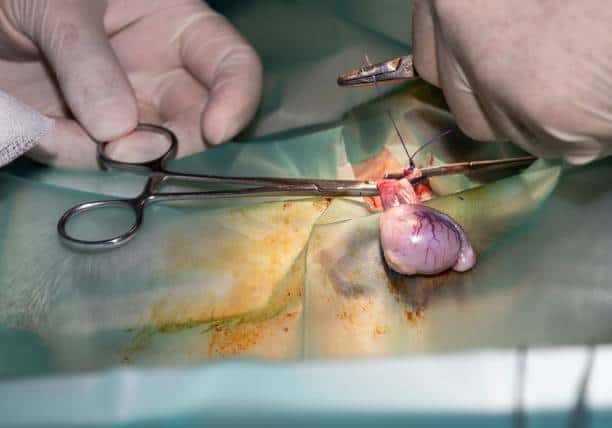The best age to neuter or spay a Labrador is between 9 and 15 months old. This is when they are physically mature enough to withstand the surgery and have had time to develop their adult personality.
70 to 85% of dogs have already been fixed in the United States. Spaying or neutering, technically known as gonadectomy, is a great way to ensure your lab lives a healthy life. Moreover, the process helps reduce health risks by eliminating unwanted pregnancies and cancer incidence.
What Is The Difference Between Spaying And Neutering?
Spaying, an ovariohysterectomy, is a process focused on intact females. It refers to removing the female reproductive organs, including her uterus and ovary. After this, the female Labrador won’t be able to reproduce. Moreover, they won’t have their heat cycle in the future.
Neutering, known as orchiectomy, focuses on intact males. It involves the removal of both testicles from a male dog so they cannot reproduce. It controls their reproductive urge and helps suppress unwanted pet behavior, including aggression.

when should i neuter my labrador?
Pet parents are often puzzled about when to neuter a Labrador and when to spay a Labrador. It has to be done at the right time. Though it does not impact the lab’s quality of life and health, it can increase health risks if done too early.
Many vets believe six months is the right age of neutering for a lab for neutering or spaying. But previous studies don’t agree, as this may enhance the risk of joint disorders and mammary cancer.
Push the age at neutering to 9-15 months of age. According to a recent study by the American Kennel Club and their Canine Health Foundation, dogs who belong to a giant breed like labs should only go for spaying or neutering after puberty.
It is recommended to go when they are over 45 pounds and between 9 and 15 months of age. Any queries on when to spay Labrador, first discuss with your vet if the time and age are correct, considering your pet’s gender, health, and size. However, the best age to spay a Labrador retriever or the best age to neuter a Labrador retriever is usually after puberty. Don’t go in too early, as you may risk joint disorders
Let’s look into the pros and cons of spaying a labrador.

9 Benefits Of Spaying Or Neutering
Getting an answer to when should you neuter a Labrador can help reduce the risk of many an illness. You should focus on when to neuter a Labrador puppy and the various benefits of spaying or neutering. The process has many benefits.
Prevents Unwanted Puppies
If you have a female lab that is not spayed, she can have over 650 puppies in six years of their maternity span. Even if you only plan to keep only a litter, intact females can have over 12 puppies for every litter. This is troublesome, hectic, and financially straining to manage.
When you go to a breeder, they will ask you to sign a form that will make you promise you will get your pup spayed or neutered at the right age.It prevents the unwanted rise in their population and harmful breeding methods. Therefore, as a pet parent, you must know when to spay Labrador retriever.
Reduces Long-Term Health Risks and Increase In Cancers
Studies prove that Labradors who get spayed or neutered live longer than their counterparts. The lifespan of a male lab increases by 13.8% and that of a female lab by 26.3% after neutering. Now, when a Labrador should be neutered for gonadectomy is not a question with a specific answer. However, if done at the right time, it will help increase your pup’s lifespan and reduce health risks, including pyometra.
Pyometra is a common life-threatening disease that results in uterine infections in labs. Getting your pup spayed at the right time will reduce the chances of getting this infection. Moreover, it protects male labs by minimizing the cases of testicular cancer. Females with neutering reduce the risk factor of ovarian, cervical, mammary, and uterine cancer.
Stops The Marking And Urinary Incontinence
One major issue is the continuous urine marking by labs. The longer your pet goes without being spayed, the higher the chances of stopping its marking. Find the best age to spay a Labrador and get them spayed at the earliest. Reducing urine marking and eliminating it.
It is critical to note that if they have been marking for a long time, it can be challenging to stop it altogether. Use different housetraining methods to change your pet’s behavior.
Less Or Zero Humping
Humping is normal for a dog during their routine play or mating. It can also be a sign of behavioral problems or can highlight their sexual urges. Though instinctive, both male and female dogs do it while exploring their bodies and sexuality. It helps them with stimulation and pleasure. This is normal behavior, including barking or jumping.
By finding the Labrador neutering best age, you can reduce this behavior. In addition, neutering and spaying can help reduce mounting by 50% to 70% in male dogs.

Lowers Risk Of Testicular Cancer And Other Testosterone-Induced Diseases
In male dogs, neutering refers to the surgical removal of testicles. The testicles are the source of testosterone for all male living beings. Testosterone impacts the sex drive, hormonal behavior, and health concerns. So, when the testicles are removed, it can help the dogs by lowering the risk of several life-threatening diseases.
Testicular cancer, prostate enlargement, and other testosterone-induced diseases are seen in dogs at a later-life stage. So after knowing when should a Labrador be neutered, act on it fast to lower the risk.
Reduce Chances Of Producing Inferior Genetic Traits And Abnormalities
Every Lab is beautiful, no matter how they look. Finding the best time to neuter Labrador reduces the risk of having pups with congenital diseases. Most breeders ensure that the puppies are purebred and do not have any genetic problems. They also monitor symptoms of hereditary health issues with the dog.
Breeders can find which dogs are better for breeding and have a lesser chance of having pups with hip dysplasia and retinal atrophy. Getting your pet neutered or spayed can help you in reducing these chances. It can avert mast cell tumors and cranial cruciate ligament tears as well
Reducing Stray Population
Neutering your pet won’t help any stray directly. But it can prevent your dog from impregnating them. Homeless dogs continuously grow, and many lose their lives as no one adopts them. Thus, finding the best time to neuter a Labrador retriever and getting it done can stop the stray population. Spaying works great for all retrievers especially golden retrievers.

Assists With Behavior Issues
As your male lab starts entering adulthood, he will likely showcase unwanted behaviors due to puberty. You might notice they are roaming more, marking urine, mounting, and showing aggression.
Neutering can help you here. The best age to neuter a male Labrador retriever is within 1 year as it will reduce such habits. Moreover, female labs won’t have heat cycles. It eliminates the chances of howling or bleeding during the reproductive process.
Touch Sensitivity
Dogs can exhibit abnormal behavior primarily because of increased testosterone levels. The best age to spay a female Labrador is 6-9 months, as it reduces negative behavior. While initially, your pet might feel fearful and sensitive to touch, they will adjust to their body changes. The behavior will improve with time, and soon they will be more affectionate.

3 Risks Of Neutering My Labrador Retriever
While getting your dogs neutered has many benefits, it also comes with some risks.
Vulnerability To Become Obese
In pursuit of “when should I get my Labrador neutered,” know that neutering can slow your pet’s metabolic rate and make them obese. Studies show neutered, or spayed animals need 25% fewer calories than intact animals. Hence if you plan to get your lab spayed or neutered, you will also have to adjust their diet, so they do not get obese.
Inability To Pass Desirable Genetic Trait
Another significant risk of getting your lab neutered is that they will not breed anymore. They won’t pass on any desirable genetic trait to the next generation. However, the overall goal is to keep them from reproducing in the future.
Growth Problems And Joint Disorders
6-9 months of age is the answer to “when should I neuter my Labrador” as per vets. Moreover, in larger breeds, such as labs, it is better to wait till two years or until they grow up. This is because their hormones play a significant role in their overall growth.
Some studies show that pets who get neutered early show signs of joint disorders. Getting your lab neutered early can prevent them from growing correctly, resulting in health issues, even elbow dysplasia.
Different Methods Of Neutering
While neutering was always a surgical procedure, today, things are different, and multiple options are available.
Male Labrador Retrievers
Castrating Male Dogs
Traditionally, neutering involved the removal of testicles from male dogs by a simple surgical procedure. The recovery is quick, and he becomes infertile immediately in the next few months.
The surgical castration method is a fully-proof, effective method of birth control. It is permanent, and you cannot get it reversed. Apart from infertility, the procedure might have other effects on the dog.
Chemical Castration
A new method of neutering is available s in limited places. It involves the usage of a chemical like Zeuterin, which is injected into the testicles of the dog. While chemical castration causes infertility, like surgical castration, it is not 100% effective.
Chemical castration is not 100% accurate as surgical castration, as some testosterone will remain. Pet owners might use it as a trial run before they go for a permanent surgical castration. Discuss the side effects of this procedure with your vet.

Female Labrador Retrievers
Spaying A Female Dog
The traditional method of spaying a dog requires abdominal surgery in which an incision is made in the belly to remove the reproductive organs. It might need your lab to rest for two weeks to recover fully. However, now alternative methods can help to spay your lab.
Laparoscopic Spay
If you want to know when a Labrador should be spayed without surgical procedure, go for a laparoscopic spay. The surgeon will create tiny incisions to remove only the ovaries from your lab. With no ovaries, your lab cannot produce estrogen and stay infertile.
The Effects Of Neutering On Dogs
Getting your dog neutered or spayed makes them infertile, but the procedure also has other effects. For example, depending on their age, there is a possibility of changes in physical appearance between an un-neutered lab and a neutered male.
Physical Changes After Neutering
Neutered males without testicles will be short-haired dogs. While it will not bother them, it can impact some owners. It is possible to get fake testicle implants, known as neuticles, to make them look like a male un-neutered lab. Furthermore, a male lab that gets neutered before reaching sexual maturity will not look as masculine as others.
They wouldn’t grow as taller as they would if not spayed. However, most of these physical changes won’t be quite evident.
Behavioral Changes After Neutering
While changes in behavior after neutering is normal, it isn’t predictable. What people assume will happen after getting their dogs neutered doesn’t always happen. The behavioral changes that a male dog will exhibit after the procedure are limited.
They can start roaming more or become touch sensitive for a few days. However, their aggressive behavior gets toned down after the process. Vets recommend that the best time to spay a Labrador is before a year, not sooner than for Labrador retrievers.

FAQs on labrador castration age
Can Neutering A Dog Too Early Cause Cancer?
While it is true that some breeds are at a higher risk of developing cancer if spayed at an early age, it is limited to a few breeds. It has been seen that cancers with neutering are on a decline and so are the occurrence of cancers or risks of cancers
At What Age Should A Male Labrador Be Neutered?
The best age to spay a female Labrador right after your lab hits puberty. Ensuring you choose the correct period will help your dog, as hormones can help them grow well during its early days.
What Is The Healthiest And Safest Age of Neutering Intact Males?
The best age to neuter Labrador is around 1-2 years. It is an ideal time as they would have hit puberty and grown physically and mentally.
What Is The Disadvantage Of Neutering A Dog?
Getting your dog neutered can have some risks. For example, they are at higher risk of joint disorders and joint issues like elbow dysplasia and hip dysplasia after the process. Some dogs might show behavioral changes.
Does Neutering A Dog Let Them Live Longer?
While neutering doesn’t directly impact the lifespan of a lab, it has an indirect impact. Getting your dog spayed will help protect them from health risks and sexually transmitted diseases. Hence helping them live longer.
What Happens If You Spay Or Neuter A Dog Too Early?
Previous studies show that if you spay or neuter your dog too early, it will face joint disorders as they grow. Moreover, it also impacts their growth.
Is Neutering Good For Labrador Retrievers and Golden Retrievers?
Neutering is undoubtedly good for your lab. Moreover, it will reduce the chances of long-term health effects like cancer.
Does Neutering Calm Male Labrador Retrievers?
If your male lab’s abnormal behavior is because of its hormones, it will surely get better after the neutering. It will help calm them down. However, remember that hormones are not the only reason behind the abnormal behavior of your pet.
When To Neuter A Male Labrador?
The best age to neuter a male Labrador is between 6 and 9 months old. This is when they are physically mature enough to withstand the surgery and have had time to develop their adult personality. However, some veterinarians may recommend neutering as early as 4 months or as late as 12 months.
Best Age To Desex Male Labrador
The term “desexing” is used interchangeably with “neutering”. So, the best age to desex a male Labrador is between 6 and 9 months old.
Do Labs Calm Down After Being Neutered?
Many Labradors do calm down after being neutered. This is because testosterone, the male sex hormone, can contribute to aggressive behavior and roaming. Neutering can help to reduce these behaviors.
What Is Labrador Neutering Recovery Time?
The recovery time for Labrador neutering is 7-10 days. During this time, your dog must be kept quiet and comfortable. You will also need to monitor their incision site for any signs of infection.
How Long To Wait To Spay After First Heat?
The American Animal Hospital Association (AAHA) recommends waiting until after your dog’s first heat to spay her. Spaying before the first heat can increase the risk of certain health problems, such as urinary incontinence. However, some veterinarians may recommend spaying before the first heat if your dog is at high risk of developing certain health conditions, such as pyometra (a life-threatening uterus infection).
How Long Do You Have To Wait To Spay A Dog After Heat?
The AAHA recommends waiting at least 21 days after your dog’s heat cycle ends before spaying her. This is to give her body time to recover from the heat cycle and to reduce the risk of complications.
What Is Dog Smegma After Neutering:
Dog smegma is a thick, white, yellow discharge that can collect around the penis. The buildup of dead skin cells, bacteria, and other debris causes it. Smegma is usually harmless and will go away within a few weeks. However, if it becomes excessive or you notice any signs of infection, such as redness, swelling, or pain, you should consult your veterinarian.
When Is The Best Time To Desex A Male Dog?
The best time to desex a male dog is between 6 and 9 months old. This is when they are physically mature enough to withstand the surgery and have had time to develop their adult personality. However, some veterinarians may recommend neutering as early as 4 months or as late as 12 months.
Author Profile

- Lifetime dog Enthusiast
- Shradha is a seasoned writer at Labradorandyou.com, an authoritative resource for all things Labrador Retriever. Her experience as a pet owner and dog enthusiast drives her to create meticulously researched and fact-checked content, offering valuable insights on Labrador training, grooming, and health. Each article reflects Shradha's passion and dedication, enriched by personal experiences with her beloved Labradors, Tom, and Kurt. Whether exploring breed-specific training techniques or providing product reviews, Shradha ensures Labrador owners receive the most accurate, up-to-date, and trustworthy information, aimed at enhancing their companions' health and happiness
Also by the author
-
 Lab-TypesJuly 8, 2025Mostbet Brasil: Web Site Oficial, Inscrição, Bônus 15 000r$ Entrar
Lab-TypesJuly 8, 2025Mostbet Brasil: Web Site Oficial, Inscrição, Bônus 15 000r$ Entrar
-
 Lab-TypesJuly 7, 2025Kostenlos Spielen Gates Of Olympus Freispiele Ohne Einzahlung
Lab-TypesJuly 7, 2025Kostenlos Spielen Gates Of Olympus Freispiele Ohne Einzahlung
-
 Lab-TypesJuly 7, 2025Fortuna Najlepsze Zakłady Sportowe Online Efortuna Pl
Lab-TypesJuly 7, 2025Fortuna Najlepsze Zakłady Sportowe Online Efortuna Pl
-
 Lab-TypesJuly 7, 2025Play Plinko At On-line Casinos For True Money
Lab-TypesJuly 7, 2025Play Plinko At On-line Casinos For True Money





